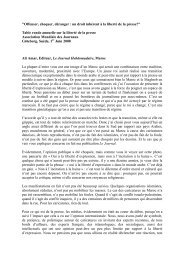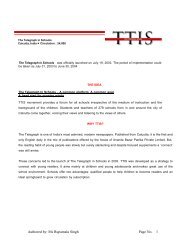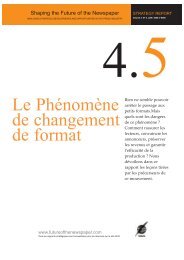WORLD PRESS TRENDS - World Association of Newspapers
WORLD PRESS TRENDS - World Association of Newspapers
WORLD PRESS TRENDS - World Association of Newspapers
You also want an ePaper? Increase the reach of your titles
YUMPU automatically turns print PDFs into web optimized ePapers that Google loves.
CANADA<br />
Commentary – CNA<br />
There are currently 102 daily newspapers in Canada, two less<br />
than in 2001, and four less than in 1999. The Saint John Times-<br />
Globe ceased publishing in November, 2001. The Cambridge Daily<br />
Reporter publishes only on a weekly-basis now, down from a<br />
six-day publishing week in 2001. The Guelph Mercury now<br />
publishes six days a week, Monday to Saturday, down from a<br />
seven-day publishing week in 2001. The Lindsay Post increased<br />
its publishing cycle to six-days, Monday to Saturday, from a<br />
five-day Tuesday to Saturday cycle in 2001.<br />
Newspaper ownership changes stirred once again toward the<br />
end <strong>of</strong> 2001, followed by calm until the middle <strong>of</strong> July 2002. In<br />
November 2001, Thomson Corporation sold the Winnipeg Free<br />
Press and the Brandon Sun to Robert Silver and Ronald Stern,<br />
owners <strong>of</strong> FP Canadian <strong>Newspapers</strong> Limited Partnership.<br />
On July 10th 2002, it was announced that CanWest Global<br />
Communications Corp. entered into an agreement with G.T. C.<br />
Transcontinental Group Ltd for the sale <strong>of</strong> 12 newspapers, 10<br />
<strong>of</strong> them dailies. Eight <strong>of</strong> the dailies are in the Atlantic provinces<br />
and two are in Saskatchewan. The transaction is expected to<br />
POPULATION<br />
close by mid-August.<br />
Total circulation levels declined in 2002 by 3.5% over an average<br />
day to reach 5,004,619 copies. Average weekly circulation<br />
dipped by 3.2% to reach 32,623,217 copies. B.C./Yukon were<br />
the only regions to register increases; Ontario suffered the most<br />
losses after posting the highest gains in 2001. The Englishlanguage<br />
dailies suffered average declines <strong>of</strong> 4%, exacerbated<br />
by the loss <strong>of</strong> two dailies. The 11 French-language dailies<br />
remained stable, and continued to capture 17% <strong>of</strong> the total<br />
circulation market. The broadsheet dailies lost 4% circulation.<br />
The tabloids remained relatively stable, dipped by 1%, and still<br />
account for 23% <strong>of</strong> the total newspaper circulation. The top 10<br />
circulation group lost the most, declining by 5% over the past<br />
year. The number <strong>of</strong> competitive newspaper markets has<br />
decreased by 1 to 10 in 2002, due to the cessation <strong>of</strong> the Saint<br />
John Times-Globe. The highly competitive Toronto market<br />
registered the most declines, dipping by 9% after a year <strong>of</strong><br />
outstanding growth in 2001. Sherbrooke, Calgary and<br />
Vancouver were the only competitive markets to register any<br />
circulation increases.<br />
Population by age and sex<br />
All individuals (12+) Male Female Households<br />
000 % 000 % 000 % 000<br />
18-24 1,757 12 893 13 864 12 12,038<br />
25-24 2,894 20 1,461 21 1,433 19<br />
35-44 3,373 23 1,688 24 1,686 22<br />
45-54 2,701 18 1,317 19 1,383 18<br />
55-64 1,662 11 823 12 839 11<br />
65+ 2,231 15 935 13 1,296 17<br />
Total 14,618 100 7,117 100 7,501 100<br />
Source: NADbank 2002 Study, ZenithOptimedia<br />
Working population by social class and sex<br />
All adults Male Female<br />
000 % 000 % 000 %<br />
A 259 3 196 5 63 2<br />
B 5,025 66 2,636 66 2,389 66<br />
C 1,174 15 277 7 897 25<br />
D 1,162 15 880 22 282 8<br />
Total 7,620 100 3,989 100 3,631 100<br />
Source: 2002 NADbank Study<br />
A = senior management<br />
B = other management or pr<strong>of</strong>essionals/other white collar<br />
C = administrative or pr<strong>of</strong>essional<br />
D = skilled service or skilled labour<br />
Age structure <strong>of</strong> readership<br />
% <strong>of</strong> % weekly reach<br />
Age readership within age group<br />
18-24 12.3 83.3<br />
25-34 19.2 79.1<br />
35-49 23.1 81.6<br />
50-54 18.9 83.4<br />
55-64 11.5 82.7<br />
65+ 15.0 80.2<br />
Source: 2002 NADbank Study, Interim Report<br />
Housewives 2001 (co-habiting persons)<br />
Housewives<br />
000<br />
18-24 913<br />
25-34 1,522<br />
35-49 2,452<br />
50-54 582<br />
55-64 797<br />
over 65 960<br />
Total 7,226<br />
Source: 2001 NADbank Study<br />
Note: Survey covers only 57% <strong>of</strong> households<br />
Household composition<br />
Households<br />
Household occupancy 000 %<br />
1 person 2,065 14<br />
2 people 4,513 31<br />
3 people 2,807 19<br />
4 people 2,972 20<br />
5 or more people 2,260 15<br />
14,617<br />
without children 9,506 65<br />
with children 5,098 35<br />
with children aged 0-6 2,070 14<br />
with children aged 6-11 2,102 14<br />
with children aged 12-17 2,489 17<br />
Total 14,604 100<br />
Source: 2002 NADbank Study, Interim Report<br />
Note: Survey covers only 57% <strong>of</strong> households<br />
Newspaper reach (%)<br />
Daily Weekly<br />
All adults 18+ 75 82<br />
Men 18+ 80 85<br />
Women 18+ 72 80<br />
MHS 73 79<br />
Source: 2002 NADbank Study, Interim Report<br />
MHS = main household shopper<br />
<strong>WORLD</strong> ASSOCIATION OF NEWSPAPERS - <strong>WORLD</strong> <strong>PRESS</strong> <strong>TRENDS</strong> 2003 73
















